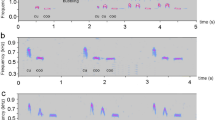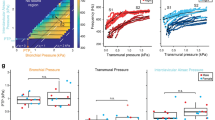Abstract
IN chicken embryos it is known that lung ventilation begins when, or just before, the embryo pierces the membrane dividing it from the air space, and is well established before hatching. Breathing is intermittent and irregular at first, becoming more regular and more rapid as hatching approaches1,2. It has also long been known that respiration in chicken embryos may be accompanied by a loud regular clicking3,4. Apart from the connexion with respiration, it is not known how these clicks are produced, although in duck embryos observed through holes made in the shell clicks are reported to coincide with movements of inspiration or expiration or both4.
This is a preview of subscription content, access via your institution
Access options
Subscribe to this journal
Receive 51 print issues and online access
$199.00 per year
only $3.90 per issue
Buy this article
- Purchase on Springer Link
- Instant access to full article PDF
Prices may be subject to local taxes which are calculated during checkout
Similar content being viewed by others
References
Kuo, Z. Y., and Shen, T. C., J. Comp. Psychol., 21, 87 (1936).
Romijn, C., Physiol. Comparata et Oecol., 1, 24 (1948).
Breed, E. S., Behav. Mon., 1, No. 1, iv + 78 (1911).
Driver, P. M., Nature, 206, 315 (1965).
Vince, M. A., Anim. Behav., 14, 34 (1966).
Author information
Authors and Affiliations
Rights and permissions
About this article
Cite this article
VINCE, M., SALTER, S. Respiration and Clicking in Quail Embryos. Nature 216, 582–583 (1967). https://doi.org/10.1038/216582a0
Received:
Published:
Issue Date:
DOI: https://doi.org/10.1038/216582a0
This article is cited by
-
Noncontact measurements of avian embryo heart rate by means of the laser speckle: comparison with contact measurements
Medical & Biological Engineering & Computing (1989)
Comments
By submitting a comment you agree to abide by our Terms and Community Guidelines. If you find something abusive or that does not comply with our terms or guidelines please flag it as inappropriate.



